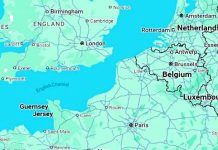
March 27 (UPI) — A new art exhibit uses toe tags attached to a large map of the U.S.-Mexico border to remind visitors that undocumented migration claims lives, said its creator, University of Michigan anthropologist Jason De León.
“The people can’t speak for themselves, but maybe their deaths can speak for them,” De León said in a telephone interview about the exhibit that opens Wednesday at the University of Michigan in Ann Arbor.
De León collaborated with photographer Michael Wells and artist/curator Lucy Cahill to produce the work.
The Hostile Terrain 94 exhibition attaches 3,000 yellow cardboard toe tags to a white wall-size Arizona-Mexico border map to visualize migrants’ deaths since 1994 and to communicate the stories of their fatal border crossings.
Toe tags are placed on corpses in morgues for identification purposes.
“This exhibition is really important, especially in today’s climate,” Nicole Smith, a UM anthropology major who is working with De León on the exhibition, told the Detroit News.
“We hear all the time on the news about immigration and building a wall and child separation. While those things are very important, there are thousands of people dying due to our border policy, and I don’t think a lot of people realize that,” Smith said.
Volunteers like Smith filled out 3,000 toe tags by hand with identifying details, including names if the corpse was identified. Each toe tag was placed precisely on the map where a migrant’s body was found. The tags stack up against each other in a swath across Arizona’s desert border, a graphic visualization of the danger that migrants confront.
“That’s just the Arizona border. The exhibit does not even include deaths in California or Texas,” De León said.
The U.S. Border Patrol recorded 7,505 deaths on the entire southwestern border from 1998 to 2018.
De León pointed to the hardening of the border as a cause of migrant deaths.
“We beef the border up in one place and it pops a hole in someplace else that is usually more dangerous,” he said.
The anthropologist said most parts of Arizona’s desert became far more difficult for migrants to cross starting in 2013 and forced them to travel through harsher, more difficult terrain, squeezing them up into the mountains and exposing them to greater dangers.
“The ways that people die in Arizona are hypothermia and exposure. Or the pre-existing conditions someone might have that the journey exacerbates,” De León said.
But he pointed out that the Arizona border hardening shifted migrants to Texas, turning it into the primary crossing corridor into the United States.
“People are also being exposed to difficult environmental conditions, including in South Texas where people often die from exhaustion and dehydration,” De León said.
But current heightened security in Texas means “all of a sudden, New Mexico has become this new path of least resistance,” he said. “And because of all this hardening of the land border, we are also seeing increased human smuggling on boats.”
De León is author of the book, Land of Open Graves: Living and Dying on the Migrant Trail, in which he advocates humane border policies. He hopes the exhibit will continue his mission to raise awareness for less deadly border policies.
“I think exposing people to nature’s danger is by design. It makes it easier for the Border Patrol to say people put themselves in harm’s way, that they do this to themselves. Instead, it’s a border policy designed to put people in harm’s way. Nature itself is a much cheaper and more effective way to kill people,” he said.
De León trained as an archaeologist, but turned to focus on immigration issues because he had to work on excavations with working-class Mexican men who all had traumatic border crossing experiences or were preparing to migrate.
“So, over the last 10 years, I transformed from an archaeologist to an anthropologist, and I’ve tried to find different ways to document, understand and present migration to the public,” he said.
The exhibit will run for three days at the university. Next year, the concept will be used for simultaneous exhibitions at 94 host sites around the world.
The current exhibition is funded by the university, De León said. The Undocumented Migration Project, the exhibition’s organizer, said on its website that it asks future host sites to pay $1,500 for shipping, installation and insurance.
To reflect each specific location’s immigration policy, hosts will develop complementary programming, De León said. For example, when the exhibition opens on the Italian island of Lampedusa in the Mediterranean, the refugees housed there will participate by filling out the toe tags by hand.
The Mediterranean is the world’s deadliest region for migrants. More than 2,000 people died trying to cross the sea into Europe last year.
“The exhibit raises the question, ‘Why is nobody talking about these deaths from so-called natural causes?'” De León said.
“If we had a border policy that killed people with bullets, more people would be paying attention,” he said. “We need to stop this policy that kills people.”





